This tour combines the two greatest ancient capital cities in China - Beijing and Xian with the holy city Lhasa in a single trip. You will firstly spend several days in Beijing to visit the world-famous attractions, such as Great Wall, Forbidden City, Temple of Heaven, etc. Then take a high speed bullet train to Xian to see the man-made wonder - Terracotta Warriors. Lastly, go to take a train to experience the highest railway in the world Qinghai Tibet Railway. As a private tour, you will be able to travel at a leisure pace with more flexibility.
Highlights of this tour:
- Spend some days exploring the ancient Chinese culture and history by visiting the famous World Heritage Sites in Beijing and Xian, such as Great Wall, Temple of Heaven, Forbidden City and Terracotta Warriors, etc.;
- Enjoy the shorter train journey to Tibet from Xian - only about 31 hours to get to the holy city Lhasa by train from Xian;
- Have a memorable trip to the holy city on the Roof of the World to explore the famous sights, such as Potala Palace, Jokhang Temple, Sera Monastery, etc.
Tour Brief Information
- Tour price: from
- Tour code: TD-CTT-10A
- Tour Type: Private Customizable Tour Package
- Destination: Beijing / Xian / Lhasa
- Duration: 10 days and 9 nights
- Departure: Flexible
- Travel Theme:





- Best Time:




- Physical Level
- Tour Pace
- Max Altitude
5,072m
- Itinerary Details
- Price Guide & Booking
- Trip FAQs
- Reviews
- Make an Enquiry
Your tour - at a glance
Day 1~4 Arrival & Beijing Tour
Day 5 Xian Tour
Day 6~7 Train to Tibet
Day 8~9 Lhasa City Tour
Day 10 Lhasa Departure
Itinerary Details - Day by Day
Day 1 Beijing Arrival ( B )
Welcome to the capital city of China! Upon arriving at the airport/train station, you will be met by your local tour guide, and then drive to your downtown hotel in Beijing City. After the hotel check-in, you are free to take a rest or explore around on your own.
Day 2 Beijing ( B, L )
China has more than 4000 years’ history of Imperial Social System, while Beijing is the best place in China to experience the magnificent history and culture of ancient China. Today your guide will pick you up in the hotel after your breakfast, then start the wonderful ancient China culture and history tour!
You will firstly get to the world's largest plaza – Tian’anmen Square. The grandiose Tian’anmen Gate was the place where the chairman Mao announced the establishment of the People’s Republic of China to the world. Passing through Tiananmen Gate, you will enter the splendid Forbidden City, the previous home to 24 emperors of Ming and Qing Dynasties for 600 years. Magnificent architectures, intricate ornaments and touching legends make it a must-see of China. In the afternoon, head to visit the stunning and exquisite Summer Palace, and be amazed at the vast ensemble of lakes, gardens, temples, and palaces, together as a masterpiece of Chinese landscape garden design. While in Qing Dynasty, it was the personal summer retreat for the royal families. It is made up of front hill, back hill and Kunming Lake. You will see splendid halls and pavilions in the front hill, while in the back hill, you will enjoy quiet and natural beauty.
After the sightseeing, you will be taken back to your hotel for rest.
Optional Recommended Night Activity: 1) watch an exciting Chinese Kungfu Show at Red Theatre which usually starts at 7:30 pm; 2) enjoy a famous Beijing Opera Show at Liyuan Theater between 19:30-21:00.
-
 A corner of the Forbidden City in Bejing
A corner of the Forbidden City in Bejing
-
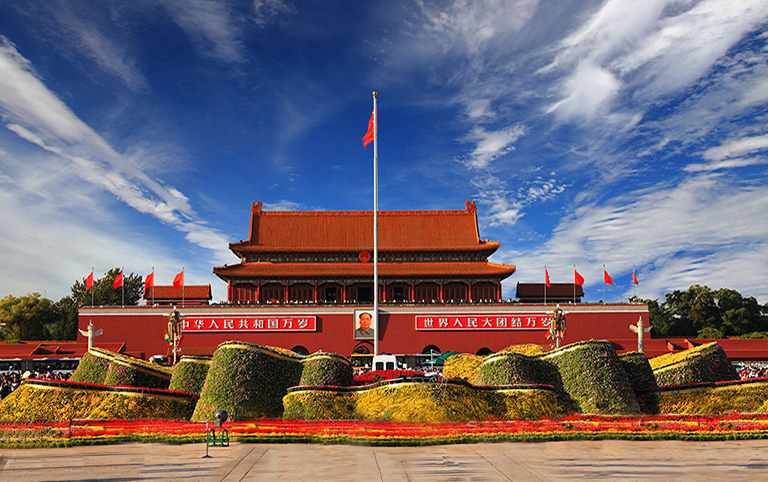 Tiananmen Square is a symbol of national cohesion
Tiananmen Square is a symbol of national cohesion
-
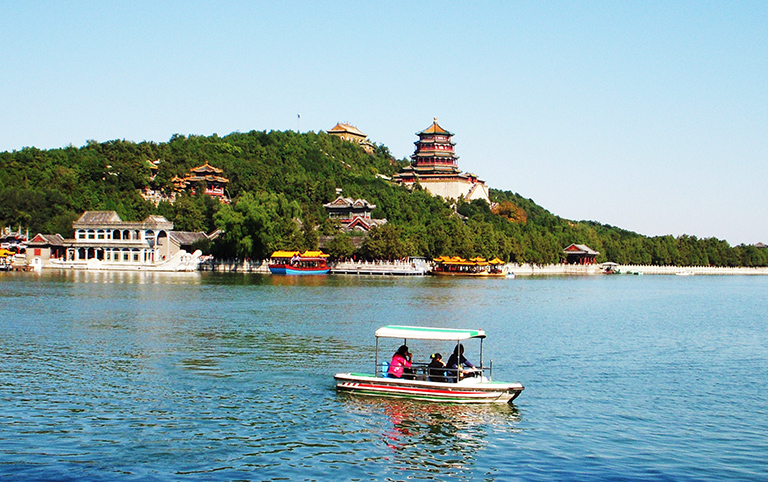 Appreciate the charm of royal garden
Appreciate the charm of royal garden
Day 3 Beijing ( B, L )
Hiking the Great Wall is one-in-a-lifetime thing to do for most travelers. Today, you are going to accomplish the Great Wall dream. You will be escorted about 70km from the downtown Beijing to the world-famous Mutianyu Great Wall which has fewer tourists compared with Badaling Great Wall. At the same time, it is the best Great Wall section to view the delicately beautiful scenery while appreciating the grandness of the Walls. After arriving at the ticket office, you will take a cable car to the walls of Mutianyu, and then hike about 2 hours on the Great Wall.
After the Mutianyu Great Wall hiking, you will drive back to the city. On route, take a sidetrip to the solemn Ming Tombs of ancient emperors in Ming Dynasty. Wander along the Sacred Road, a tranquil royal path featured with statues of divine animals and officials; also take an adventure to the mysterious Underground Palace. Before getting to your hotel, you will also make a stop at the Beijing Olympic Village to take some pictures of the world-famed "Bird’s Nest" and the "Water Cube" from the outside.
Optional Recommended Activity: enjoy a dinner of authentic Peking Roasted Duck at Quanjude Restaurant.
-
 Hiking on the beautiful Mutianyu Great Wall
Hiking on the beautiful Mutianyu Great Wall
-
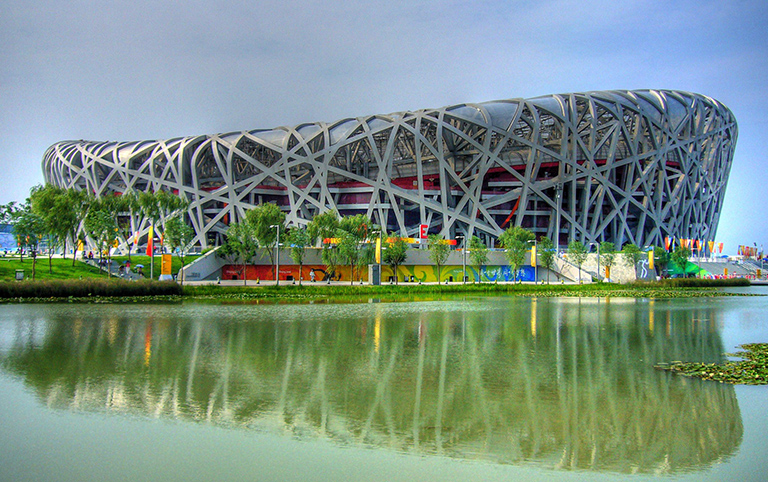 Have a Glimpse of the Bird's Nest
Have a Glimpse of the Bird's Nest
Day 4 High Speed Train to Xian from Beijing ( B, L )
After breakfast, you'll go to marvel at one of the greatest masterpiece in Chiense architecture history - the Temple of Heaven, where the ancient emperors used to preside at various rituals for a national good harvest in ancient times. Today, the outer area of the Temple of Heaven is a public park for locals to gather to play Taichi, fly kites, chatting… while the inner area is the historical site for tourists to learn about the ancient Chinese history and culture. Later move on to visit the most famous Hutongs which are some old alleys with traditional architecture originated from Yuan Dynasty (CD 1271~1368. Today, there are still many local Beijingers living in these old quarters, while in the Qing Dynasty (CD 1636~1912), there were even some noble royal families resided here. You can wander leisurely around these narrow alleys to experience the original features of people’s living in old time, or take a relaxing rickshaw through. Lunch will be arranged at a local family who lives in Hutong.
After the lunch, you will have some free time until be taken to catch a high speed train to Xian. Our local guide will be waiting for you in train station and escorting you to your hotel in Xian. The rest of day is free for you to explore the ancient city on your own.
-
 Hutong Tour
Hutong Tour
-
 Temple of Heaven Is A Masterpiece of Chinese Architecture
Temple of Heaven Is A Masterpiece of Chinese Architecture
Day 5 Xian ( B, L )
After breakfast, drive about 1.5 hours to witness the magnificent man-mad wonder - the Terracotta Warriors and Horses, which were interred to protect Qin Shi Huang (the first Emperor of China) in his afterlife. Over 8,000 life-sized terracotta warriors and horses with different looks and numerous bronze weapons compose a large-scale army system to reappear the majestic momentum of the Qin Army 2,000 years ago.
In the afternoon, drive back to Xian city to visit the Ancient City Wall, the largest and best-preserved ancient city wall in China. Built in Ming Dynasty as a military defense, the wall’s top is wider than its height to allow the army drill. Stroll on the top of the ancient wall and observe the modern Xian, emerge yourself in the charm of this ancient capital. Your next place is to go is the nearby Muslim Quarter, a place to satisfy your stomach with various delicious local foods and snacks. It is also a wonderful place for a leisure walking around.
Optional Recommended Activity: 1) biking for a while on the Ancient Great Wall; 2) enjoy a wonderful performance of Tang Palace Dancing Show (usually from 8pm to 9pm).
-
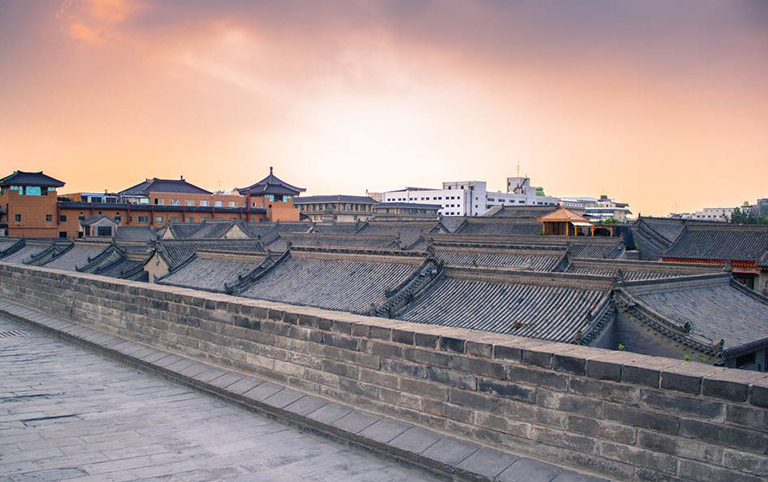 Ancient City in Dusk
Ancient City in Dusk
-
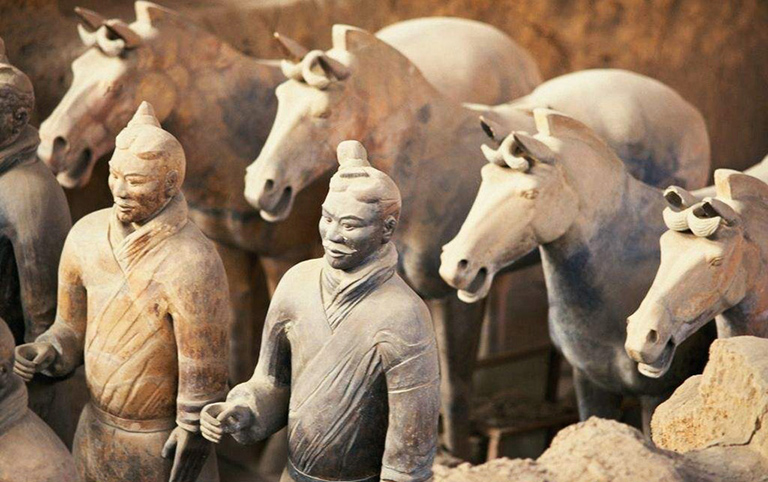 Terra-Cotta Warriors is the eighth wonder of the world
Terra-Cotta Warriors is the eighth wonder of the world
Day 6 Train to Lhasa from Xian ( B )
Today you are going to take a train to the holy city Lhasa from Xian. Currently there are two trains travelers can take to Lhasa from Xian - Z165 and Z265. Every day, the Train Z164 leaves from Shanghai Railway Station at 20:08pm and gets to Xian Railway Station at 11:14, and makes a stop around 8 minutes. While the train Z264 departs from Guangzhou Railway Station, reach Xian Railway Station at 09:36am of next day, and make a stop around 9 minutes. Geographically speaking, train ride from Xian to Lhasa is much shorter than some other long-distance train trip from Beijing, Chengdu, Shanghai, Guangzhou and Chongqing. It takes only about 31 hours. Passengers only need to spend a night on the train, but don’t have to miss the highlighting Qinghai Tibet Railway. From Xian, you have to pass only 4 midway stations (Lanzhou, Xining, Golumd and Ngachu) before final arrival at Lhasa Railway Station.
-
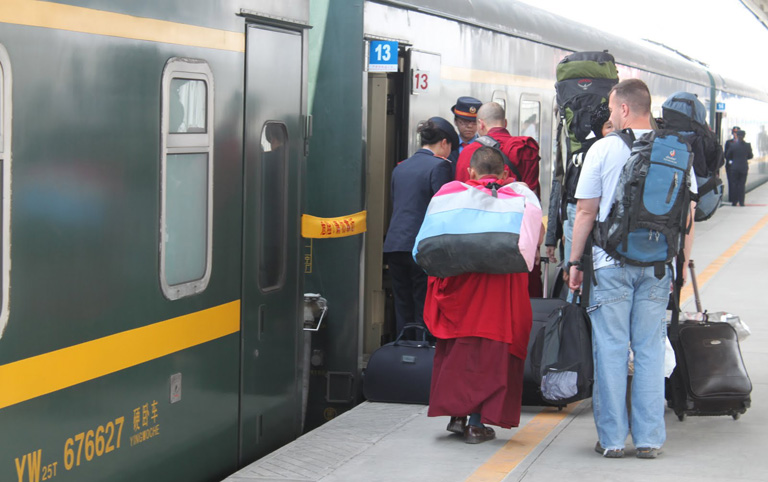 Take a Train to Tbiet
Take a Train to Tbiet
-
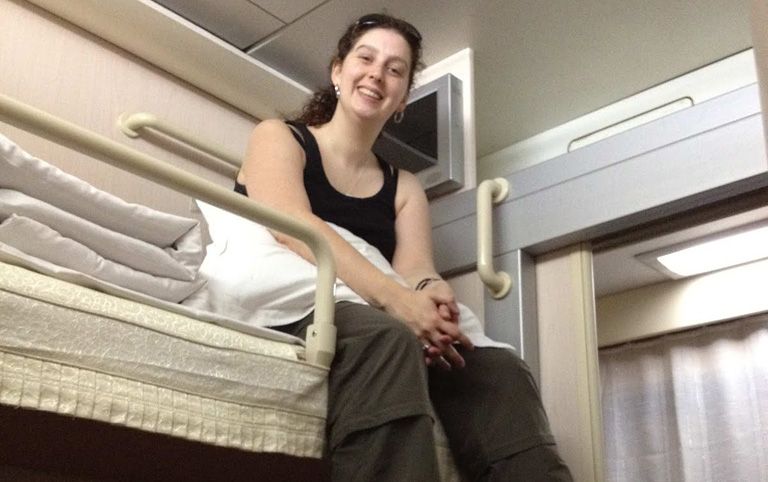 Soft Sleeper on Tibet Train
Soft Sleeper on Tibet Train
Day 7 Qinghai Tibet Railway - Lhasa Arrival
The Qinghai Tibet Railway is known as “Heaven Road”, originated from Xining, passing through Golmud, Kunlun Mountains Pass and Tuotuohe Town (origin of Yangtze River), crossing the Tanggula Mountain Pass and Changtang Grassland, and getting to the holy city Lhasa. It has created 9 incredible world records - the HIGHEST railway in the world, the LONGEST plateau railway in the world, the LONGEST plateau railway crossing frozen earth in the world, the HIGHEST railway station in the world, the HIGHEST tunnel built on permafrost, the LONGEST plateau tunnel built on permafrost, the HIGHEST railway construction base, the LONGEST railway bridge, the Max Speed the of plateau railway.
During your train journey to Lhasa, You will have chance to enjoy the unique charming scenery along the railway, such as the ysterious Kunlun Mountains, wild Hohxil Nature Reserve, the “Elf of Qinghai Tibet Plateau” - Tibetan Antilope, the Origin of Yangtze River, dominating Tanggula Mountains, blue Diamond - Tsonag Lake, the Largest Pasture in Tibet - Changtang Grassland, etc.
You will arrive at Lhasa Railway Station in the late afternoo, and then be picked up by our local tour guide and driven to your hotel in the downtown. Have a good rest.
High Altitude Acclimation Tips:1) go for some leisure walking to acclimate the high altitude but avoid strenuous activity after arrival; 2) you'd better not have bath, in case of catching a cold; 3) drink more water, and have some fruit; 4) have a good rest.
-
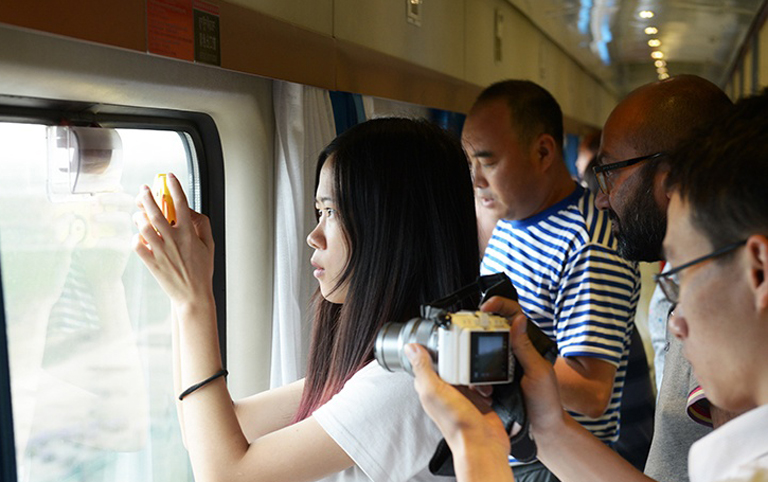 Enjoy Stunning Landscape along the Tibet Train Trip
Enjoy Stunning Landscape along the Tibet Train Trip
-
 Snow-Capped Tanggula Mountains along the Qinghai Tibet Railway
Snow-Capped Tanggula Mountains along the Qinghai Tibet Railway
-
 The clean Tsonag Lake along Qinghai-Tibet Railway
The clean Tsonag Lake along Qinghai-Tibet Railway
Day 8 Lhasa ( B )
Start today’s Lhasa exploration with an exciting visit to the landmark - Potala Palace which is regarded as one of the most beautiful architectural building in the world. You will climb up the palace along the zigzag stone paths with white-and-red walls to the top of the palace where you can not only appreciate the exotic Tibetan-style architecture, but also get a great view of Lhasa’s urban areas, then walk into the inner space of Potala Palace to explore the stately chapels and learn about the history of the palace.
Continuing your exploration, you will then get to Jokhang Temple which is considered as the spiritual heart of Tibetan Buddhism. Each day, there are thousands of pilgrims coming from different places in Tibet to the temple to worship to the Buddha. This temple is also known as the “house of Buddha” because it keeps the precious Jowo Rinpoche, the life-sized (5 foot/1.5m) image of the Shakyamuni at the age of 12. The last site for today’s exploration is the famous Barkor Street. It is a circular and wide street encircling the Jokhang Temple. The local people like to walk on the street for several circles usually in the late afternoon as a daily tradition of pilgrimage. The street also has many shops selling a wide variety of traditional Tibetan goods, religious items and handcrafts.
Tips of today: 1) there are 1,080 steps up to climb to the top of Potala Palace, so don’t walk in a rush, which may cause high altitude sickness; 2) taking photos is not allowed inside the palace; 3) today you will be mainly outside, please bring some water, a hat, sun cream, and sun glasses with you.
-
 Great view of Potala Palace in the evening
Great view of Potala Palace in the evening
-
 Golden Roof of Jokhang Temple
Golden Roof of Jokhang Temple
-
 Souvenirs Sold on Barkhor Street
Souvenirs Sold on Barkhor Street
Day 9 Lhasa ( B )
After breakfast, you will firstly go to visit the beautiful Norbulingka which used to be the former summer palace of Dalai Lamas in the ancient time, and now is a public park. It is famous for its Potrang, the private palaces of former Dalai lamas with grandiose Tibetan architecture style. Next, drive several kilometers to the western outskirts of Lhasa to visit Drepung Monastery. Drepung, in Tibetan, means “prosperity”. Since its establishment, Drepung Monastery has always been one of the most important Buddhist monasteries in Tibet. In its heyday, there were more than 10,000 monks lived and studied in the monastery. Throughout its history, many important and famous Tibetan leaders used to study here, especially the Dalai Lamas. So Drepung Monastery is also respectfully known as the “Mother School of Dalai Lamas”.
In the afternoon, you will be taken to another famous monastery in Lhasa - Sera Monastery. It is famous for the spectacular “Buddhism Debating”. As a daily routine, the monks gather in a courtyard, and debate on the Buddhist doctrines with supplemented gestures, which is thought to be helpful to facilitates better comprehension of the Buddhist philosophy to attain higher levels of study. After enjoying the "Buddhism Debating", you will be transferred back to the city. The rest time is your own free time to rest.
The Etiquette of Visiting Monastery: 1) you shouldn’t wear short and uncover shoulders; 2) taking off your sunglasses and hat before entering the chapels; 3) taking photos is usually not allowed inside the chapels.
-
 Buddhism Debating Scripture with dramatic gestures in Sera Monastery
Buddhism Debating Scripture with dramatic gestures in Sera Monastery
-
 First Sight of Drepung Monastery
First Sight of Drepung Monastery
-
 Norbulingka Park is a good summer resort in Lhasa
Norbulingka Park is a good summer resort in Lhasa
Day 10 Lhasa Departure ( B )
Today is free for you until your tour guide transfer you to the airport in time for your flight or drop you off at Lhasa train station.
Tips of Today: 1) please pack your luggage carefully, especially for small things like camera charger, power adaptor, mobile phone, phone charger, wallet and towel; 2) if your flight is arranged in the afternoon, please make sure you check out the hotel before 12pm.
Useful Trip Notes
-
- 1. Tibet Permits Guaranteed
To travel in Tibet, all Non-Chinese passport holders need to have a Tibet Travel Permit which is issued by Tibet Tourism Bureau in Lhasa. And only Chinese travel agencies like Tibet Discovery can apply for the permit on behalf of tourists. You must obtain it before your tour starting because the permit will be checked when you board your flight/train to Tibet. Traveling with Tibet Discovery, you don't have to worry about the complicated procedures of Tibet Travel Permit application. All you have to do is to confirm a tour package with us and send us your passport and Chinese visa copies at least 15~20 days in advance before your tour, then we will take care of all the rest things. Once the permit is issued, we will deliver to your address in China, such as your hotel, local travel agency, etc.
-
- 2. Available Months to Visit Tibet
Generally speaking, April to October is the best time. July and August are the peak season and rainy season. It is usually snowy and cold in winter, which is not suitable for visit Mount Everest, Namtso and Mount Kailash regions. While other places such as Lhasa, Gyantse and Shigatse are suitable for travel all year around. The temperatures in daytime and night differs a lot, usually 5~15℃ in the daytime and -5~0℃ in the night, so please wear accordingly.
-
- 3. High Altitude Sickness
The average altitude of Tibet is about 4000 meters above the sea level (Lhasa: 3700m; EBC: 5200m; Namtso: 4718m). You may suffer a bit from High Altitude Sickness in the beginning days of your Tibet trip if you haven’t had rich high plateau travel experience. But don’t worry too much, the high altitude can be acclimatized usually in 2~3 days. Our suggestion is to take a physical examination and get suggestions from your doctor, and also bring some medicines to prevent from High Altitude Sickness before your trip. While in Tibet, you should keep warm all the time, avoid strenuous activities, drink more water and eat more vegetables and carbohydrates. You’d better not take showers during the first two days after your arrival in Tibet. If you don’t feel well, get help from your tour guide or go to the hospital without any delay.
-
- 4. How to Go to Tibet
Basically you have two options – flight and train. Currently, you can take a flight to Lhasa from Beijing(4.5hrs), Xian(3.7hrs), Chengdu(2.5hrs), Chongqing(3hrs), Kunming(3hrs), Kathmandu (1.5hrs), etc. Among all these cities, Chengdu and Xian have more frequent flights to Lhasa.
If you prefer a train travel, you can take a train to Tibet from Beijing(40.5hrs), Xian(32hrs), Chengdu(43hrs), Shanghai(47hrs), Chongqing(42hrs), Lanzhou(25hrs), Xining(22hrs), Guangzhou(54hrs). -
- 5. Packing and Wearing Ideas
Firstly you can’t forget your passport and Chinese Visa. A large backpack and a smaller one are recommended (the smaller one can be used for daily activities). Also bring necessary medicine you need. Other stuffs like sunglasses, snow glasses, hats, lip balm, sun block are recommended.
As for wearing, you are suggested to dress in layers (both thin and thick jackets). Down jacket is necessary in Spring and Autumn. A pair of durable and comfortable shoes is necessary.
Recommended Tibet Group Tour Packages
Escorted by a skilled driver and companied by a professional local tour guide to organize all the activities, all you have to do is to enjoy your fantastic Tibet journey.Following are some other recommended Tibet group tour packages that you may be interested in. You can also contact us to customize a trip if you want..
-

Shanghai / Chengdu / Lhasa / Xian / Beijing
13 Days China Highlights Tour with Panda Visit and Tibet Discovery
Highlights: The Bund, Chengdu Panda Base, Terra-cotta Warriors, Potala Palace, Great Wall
-
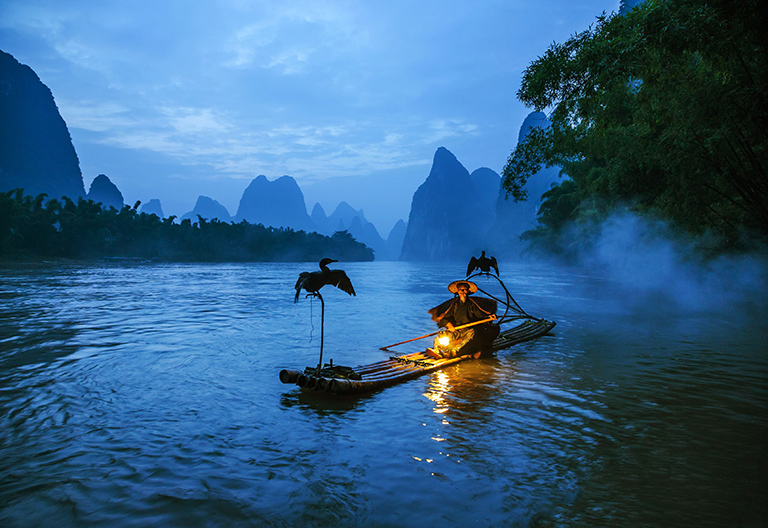
Shanghai / Guilin / Chengdu / Lhasa / Xian / Beijing
15 Days Essential China Odyssey Tour with Guilin Paradise Vacation
Highlights: Li River, Giant Panda, Terra-cotta Warriors, Potala Palace, Great Wall
-
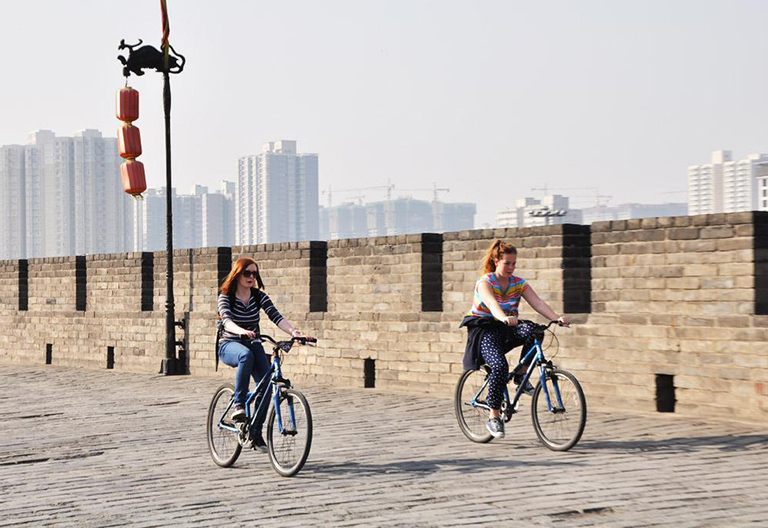
Shanghai / Xian / Lhasa
9 Days Wonderful Shanghai Xian Lhasa Contrast Tour
Highlights: The Bund, Terracotta Warriors, Potala Palace, Jokhang Temple







 Karen
Karen Wonder
Wonder Jack
Jack Rita
Rita Johnson
Johnson Vivien
Vivien Wing
Wing Ariel
Ariel Leo
Leo Tracy
Tracy Evelyn
Evelyn April
April Phoebe
Phoebe Kelly
Kelly Shirley
Shirley Reya
Reya Juliet
Juliet Elk
Elk Karina
Karina Tammy
Tammy Felix
Felix Sean
Sean